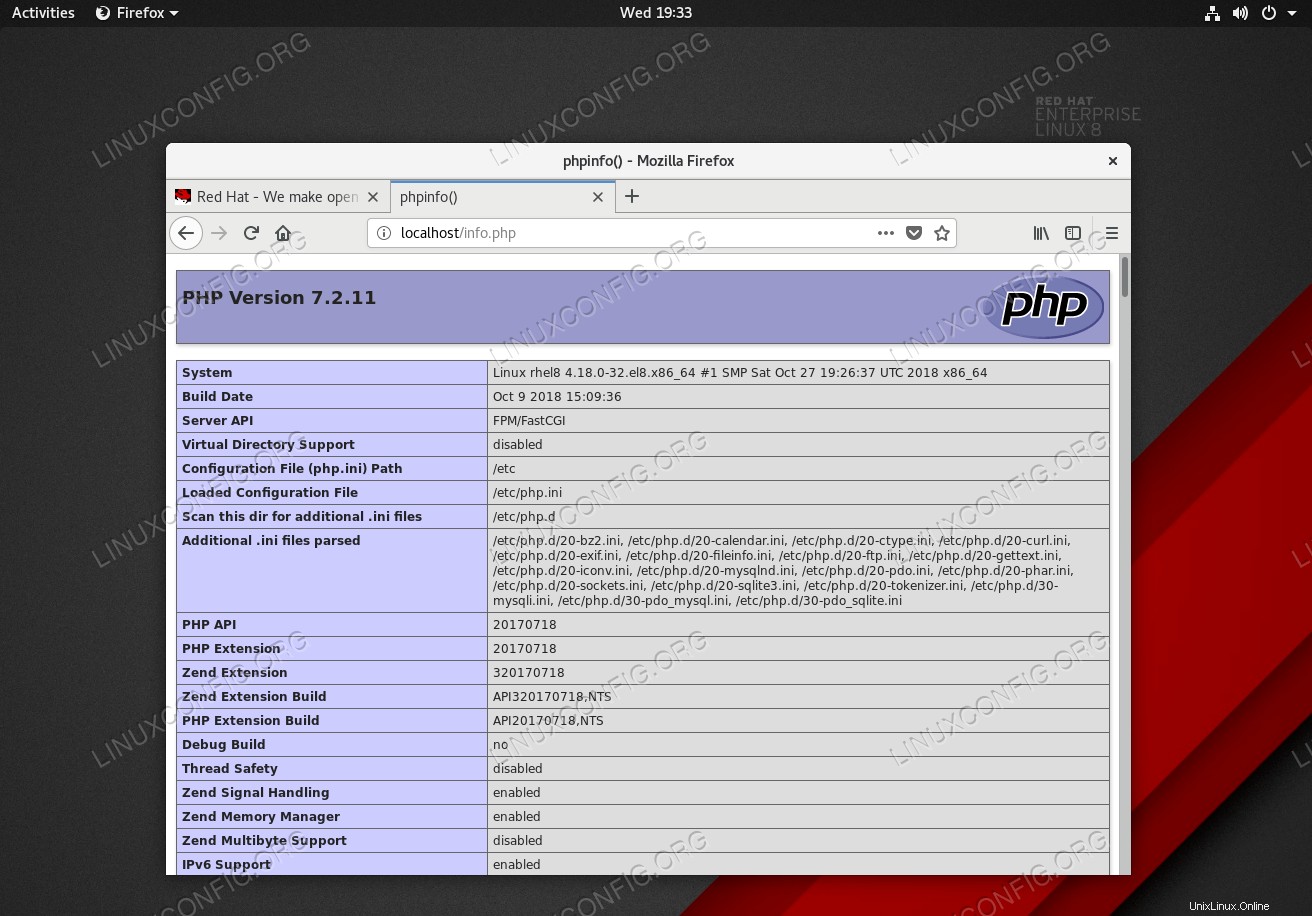Server LAMP adalah dasar dari web hosting Linux. Jika Anda ingin menyiapkan tumpukan LAMP untuk menghosting situs web Anda, panduan ini akan memberi Anda informasi yang diperlukan tentang cara memulai LAMP di server Linux RHEL 8 / CentOS 8.
Dalam tutorial ini Anda akan mempelajari:
- Cara menginstal semua paket prasyarat LAMP di RHEL 8 / CentOS 8.
- Cara mengamankan database MariaDB.
- Cara memulai layanan httpd dan MariaDB.
- Cara membuka port firewall HTTP dan HTTPS.
 Instalasi server tumpukan LAMP pada RHEL 8 / CentOS 8.
Instalasi server tumpukan LAMP pada RHEL 8 / CentOS 8. Persyaratan dan Konvensi Perangkat Lunak yang Digunakan
| Kategori | Persyaratan, Konvensi, atau Versi Perangkat Lunak yang Digunakan |
|---|---|
| Sistem | RHEL 8 / CentOS 8 |
| Perangkat Lunak | Server MariaDB 10.3.10, PHP 7.2.11-1, Apache/2.4.35 (Red Hat Enterprise Linux) |
| Lainnya | Akses istimewa ke sistem Linux Anda sebagai root atau melalui sudo perintah. |
| Konvensi | # – membutuhkan perintah linux yang diberikan untuk dieksekusi dengan hak akses root baik secara langsung sebagai pengguna root atau dengan menggunakan sudo perintah$ – membutuhkan perintah linux yang diberikan untuk dieksekusi sebagai pengguna biasa yang tidak memiliki hak istimewa |
Cara menginstal Server LAMP di RHEL 8 / CentOS 8 Linux petunjuk langkah demi langkah
- Instal semua prasyarat. Perintah berikut akan menginstal semua prasyarat paket dan alat yang diperlukan untuk melakukan instalasi LAMP:
# dnf install php-mysqlnd php-fpm mariadb-server httpd
- Buka HTTP dan secara opsional HTTPS port 80 dan 443 di firewall Anda:
# firewall-cmd --permanent --zone=public --add-service=http # firewall-cmd --permanent --zone=public --add-service=https # firewall-cmd --reload
- Mulai server web Apache dan layanan MariaDB:
# systemctl start mariadb # systemctl start httpd
Aktifkan MariaDB dan httpd untuk memulai setelah sistem di-boot ulang:
# systemctl enable mariadb # systemctl enable httpd
- Amankan instalasi MariaDB Anda dan setel kata sandi root:
# mysql_secure_installation
- Konfirmasi penginstalan server LAMP. Buat file bernama
info.phpdalam/var/www/html/direktori dengan konten berikut:<?php phpinfo(); ?> - ubah izin dan ubah konteks keamanan file SELinux:
# chown -R apache:apache /var/www/html/* # chcon -t httpd_sys_rw_content_t /var/www/html/ -R
- Arahkan browser Anda ke
http://localhost/info.phpURL dan konfirmasi pemasangan LAMP. - Instal modul PHP tambahan. Sejauh ini kami baru saja memasang tumpukan LAMP tanpa tulang. Tergantung pada aplikasi yang akan Anda gunakan, Anda mungkin juga perlu menginstal modul PHP tambahan. Perintah berikut mungkin memberi Anda beberapa petunjuk:
# dnf search php- php-gd.x86_64 : A module for PHP applications for using the gd graphics library php-fpm.x86_64 : PHP FastCGI Process Manager php-pdo.x86_64 : A database access abstraction module for PHP applications php-gmp.x86_64 : A module for PHP applications for using the GNU MP library php-dbg.x86_64 : The interactive PHP debugger php-pdo.x86_64 : A database access abstraction module for PHP applications php-xml.x86_64 : A module for PHP applications which use XML php-fpm.x86_64 : PHP FastCGI Process Manager php-cli.x86_64 : Command-line interface for PHP php-dba.x86_64 : A database abstraction layer module for PHP applications php-soap.x86_64 : A module for PHP applications that use the SOAP protocol php-snmp.x86_64 : A module for PHP applications that query SNMP-managed devices php-ldap.x86_64 : A module for PHP applications that use LDAP php-pear.noarch : PHP Extension and Application Repository framework php-intl.x86_64 : Internationalization extension for PHP applications php-json.x86_64 : JavaScript Object Notation extension for PHP php-odbc.x86_64 : A module for PHP applications that use ODBC databases php-devel.x86_64 : Files needed for building PHP extensions php-pgsql.x86_64 : A PostgreSQL database module for PHP php-common.x86_64 : Common files for PHP php-common.x86_64 : Common files for PHP php-recode.x86_64 : A module for PHP applications for using the recode library php-bcmath.x86_64 : A module for PHP applications for using the bcmath library php-xmlrpc.x86_64 : A module for PHP applications which use the XML-RPC protocol php-mysqlnd.x86_64 : A module for PHP applications that use MySQL databases php-enchant.x86_64 : Enchant spelling extension for PHP applications php-process.x86_64 : Modules for PHP script using system process interfaces php-mysqlnd.x86_64 : A module for PHP applications that use MySQL databases php-opcache.x86_64 : The Zend OPcache php-mbstring.x86_64 : A module for PHP applications which need multi-byte string handling php-pecl-zip.x86_64 : A ZIP archive management extension php-embedded.x86_64 : PHP library for embedding in applications php-pecl-apcu.x86_64 : APC User Cache php-pecl-apcu-devel.x86_64 : APCu developer files (header)
Untuk menginstal paket tambahan, jalankan:
# dnf install PACKAGENAME
Setelah paket diinstal, muat ulang
httpdlayanan:# systemctl reload httpd
Semua selesai.